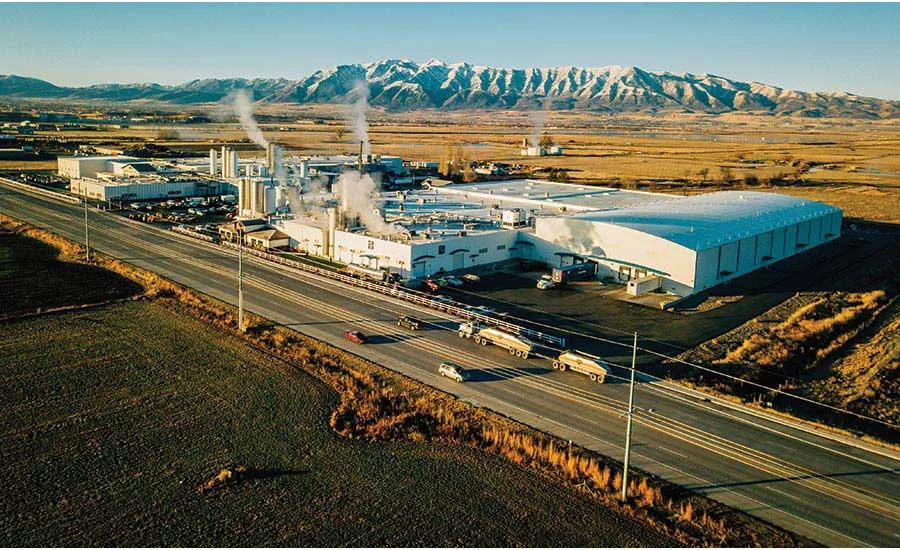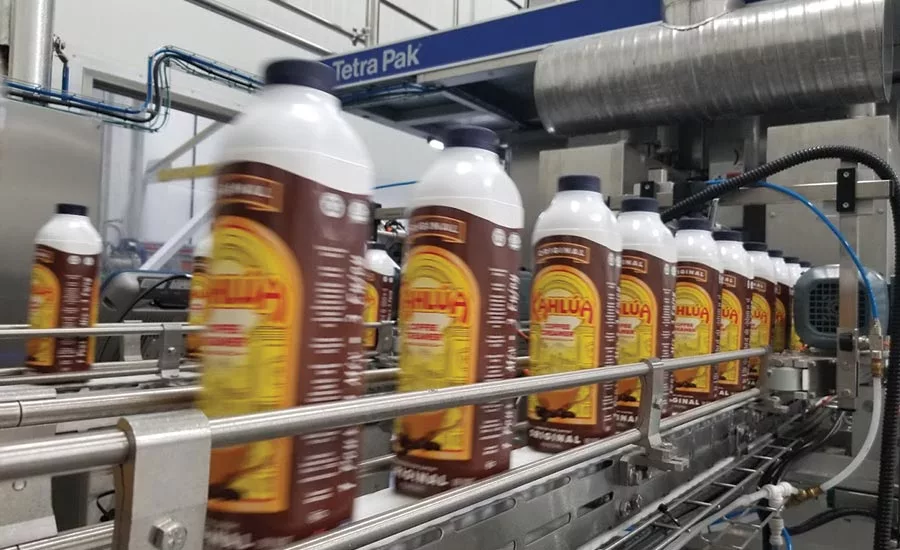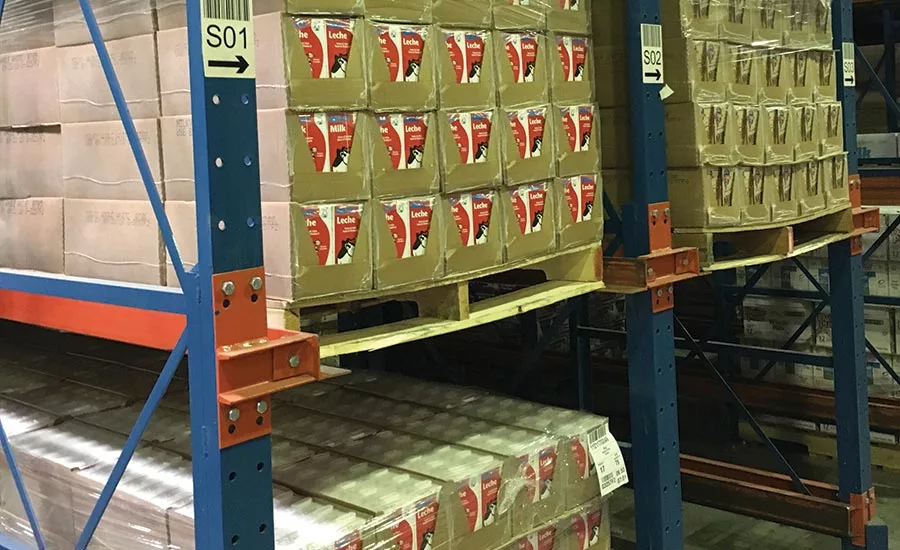Cover Story
Technology helps processors produce natural foods and beverages
How processors are using minimal processing equipment and techniques to keep up with changing consumer demands

Photos Courtesy of Tetra Pak, Gossner Foods

Gossner Foods, located in Logan, Utah, has a 25,000-sq.-ft. processing facility and 30,000-sq.-ft. warehouse for its aseptic milk production operations.

The new Kahlua Coffee Creamer, a dairy-based, nonalcoholic product distributed by Diversified Foods, Inc., is being aseptically produced by the Tetra Pak A6 and packaged in the Tetra Evero carton bottle at the Gossner Foods plant.

Multiple pallets of shelf-stable milk stand in Gossner Foods’ warehouse waiting to be shipped to Puerto Rico to help with the recovery effort after Hurricane Maria.
One of the top trends in the food and beverage industry is more new products being marketed as “natural” and “functional.” This shift is being fueled by changing consumer behavior.
“Health consciousness among consumers and consumer demand for comprehensive labeling of products, ingredients and nutritional values, together with regulatory restrictions on usage of artificial/synthetic additives in beverage products, have driven the beverage manufacturers toward adoption of natural ingredients,” says Priyanka Goswami, food, beverage and agriculture research analyst at MarketsandMarkets.
Many food and beverage producers are using new technology to make products that will satisfy modern consumer tastes, as well as to differentiate their items on the shelf.
“Emerging food processing technologies, such as HPP, pulsed electric fields, cold plasma, ultrasound, control systems and robotics, are expected to experience growth in the food and beverage processing [industry],” Goswami says. “Key F&B manufacturers are actively investing in technological advancements of their production processes.”
This article explores examples of companies investing in new technology to improve the processing and packaging of healthier food that will help meet consumer demand. And it highlights the equipment companies trying to help them advance the food and beverage processing industry.
Gossner Foods
Gossner Foods is a contract manufacturer located in Logan, Utah. The company was created by Edwin Gossner, a Swiss immigrant who first started a dairy co-op in the Cache Valley, then began making Swiss cheese in the mid-1960s.
Even though the company still produces Swiss cheese that uses the same formula developed by Gossner, it utilizes state-of-the-art equipment for aseptic milk packaging and cheese making. One of its newest additions is the installation of the first Tetra Pak A6 filling machine located in the US. This equipment forms, sterilizes and fills Tetra Evero packages, which are the first aseptic carton bottles.
“We launched the Tetra Evero in Europe six years ago, which was successful and brought incremental growth for brands there. So, we are excited to launch this package now in the US,” says Carmen Becker, president and CEO of Tetra Pak US and Canada. “We think it’s a great tool for American beverage companies to use to differentiate their products on a very busy shelf.”
She says Tetra Evero is special because of the functionality it delivers, that of a traditional bottle with the environmental benefits of a carton. Plus, it has an iconic shape that is different from the rest of the bottles currently on the market. And aseptic processing and packaging can open up many opportunities in formulation, shipping and storage, as well as merchandising.
“Tetra Evero will help brands meet consumers’ nutritional and lifestyle needs and allows them to do it with a quality product that doesn’t need any added preservatives,” Becker says. “We’ve partnered with a very bold brand owner [Gossner Foods] that can take this package and differentiate their product while protecting what’s good.”
Since starting its milk plant in 1982, Gossner Foods has had a relationship with Tetra Pak. At that time, having shelf-stable food and beverage products wasn’t as widely accepted in the US as it was in European markets.
“In recent years, the US has picked up on plant-based products and chicken broth in shelf-stable formats, but not really dairy,” says Kelly Luthi, vice president of aseptic operations at Gossner Foods. “So, we feel like the opportunities are continuing to grow for shelf-stable dairy, and we feel [aseptic packaging] gives us a better chance to get more people to drink more dairy.”
Like other aseptic packages, Tetra Evero can be stored, shipped and presented on the retail shelf, either in ambient or chilled environments. Because the multilayer packaging material preserves product quality and nutrition, the product does not need preservatives or refrigeration.
When touring Gossner Foods’ 30,000-sq.-ft. warehouse, multiple pallets of shelf-stable milk were waiting to be shipped to Puerto Rico to help with the recovery effort after Hurricane Maria. Luthi says because refrigeration isn’t necessary in the supply chain, this type of product becomes very important in natural disaster situations, as it also did during the 2017 storm events in Florida and Houston.
“Additionally, it also offers savings in the distribution channel,” says Luthi.
Because no refrigeration is required in the supply chain, aseptic packaging reduces the energy usage and the costs associated with transporting and storing chilled foods and beverages. Plus, the packaging is light and easier to ship due to its square shape.
Gossner Foods produces approximately 4.5 million milk packages per week on a total of nine filling lines, including the new Tetra Pak A6, three Tetra Brik Aseptic 8-oz. lines, one line producing 8-oz. Tetra Prisma Aseptic, two Tetra Brik Aseptic liter lines with flip caps, a Tetra Brik Aseptic liter line that features HeliCap and one line that fills bag-in-the-box packaging, which is the only filler not from Tetra Pak.
Gossner’s newest filling machine, the Tetra Pak A6 for Tetra Evero, has a unique gas-phase sterilization technique to ensure product safety and shelf stability. To create the unique bottle-shaped top on the carton, the equipment contains the world’s fastest direct injection molding technology—and the first seen in an aseptic packaging system. Moreover, the Tetra Pak A6 takes up half the space of an aseptic PET line.
Perfect Fit Meals
Perfect Fit Meals was one of the first companies to come out with premium, ready-to-eat (RTE) meals produced by using high-pressure pasteurization (HPP). The company was founded in 2010 by two fitness experts who were looking for better-for-you meals that were ready quickly and also tasted great.
Jasmine Sutherland, president of PFM and a featured speaker at the Food Automation & Manufacturing Conference in Bonita Springs, FL taking place this April, says finding RTE foods she wanted to eat was a challenge.
But Sutherland then learned about HPP, a non-thermal pasteurization method designed to inactivate pathogenic bacteria, rendering food or beverages safe while extending their shelf life. She worked with Avure, now owned by JBT, to help her test ideas that she wanted to put into the market.
“In addition to a food lab and HPP machine, their team of microbiologists also helped me structure studies to validate the safety of our product,” Sutherland says. “We did not have to outlay a large amount of capital and could minimize whom we shared our product development ideas with. It was an incredibly valuable service, and Dr. Errol helped to simplify the process, so I could explain to my team what we could accomplish with HPP.”
Approved by FDA and USDA, HPP is a cold pasteurization technique and, thus, does not alter heat-sensitive foods, such as meats, fruits and vegetables.
“Food and beverage applications that HPP works well with include: ready-to-eat and ready-to-cook meats, ready-meals, guacamole, salsa, hummus, juices and smoothies, soups and sauces, wet salads and dips, baby food, dairy products, seafood and shellfish,” says Lisa Wessels, JBT/Avure CMO.
The process can also be used for both organic and natural foods. But perhaps, the biggest selling point with this method is that the flavor, vitamins and nutrients of the natural food are all preserved.
“The taste and sensory feel of the product remain intact vs. heat, chemical or irradiation methods of preserving food,” Wessels adds.
Because JBT/Avure provides in-house food science, chemistry lab and advanced microbiology services, the company can proof recipes in its food science kitchen and test them on a full-size production machine. The formulations can also be adjusted in house to optimize flavor, texture and appearance.
“Avure was able to help us run more in-depth studies to be compliant with regulatory agencies,” says Sutherland. “In addition, they helped us to demonstrate the superiority of HPP as a processing technology to auditors. The team at the food lab has been a good sounding board, as we have wanted to enter new categories with HPP products and needed assistance in tweaking formulations.”
The investment and gamble on relatively new technology have paid off. PFM now sells 17 different ready-to-eat meals at premium grocery stores across the United States, and it’s continuing to expand its meal offerings and geographical locations. PFM’s customer-driven meal development program ensures that the meal variety, seasonal menu selections and protein options are aligned with timely customer trends.
Solve For Food
Solve For Food is a new food processing innovation startup focused on modernizing food production and headed by some long-time food and beverage veterans.
When former EVP of Sam’s Club Greg Spragg was approached by some of his former colleagues to be president and CEO of Solve For Food, he was happy to do it. Spragg, who retired in 2008, saw the food startup as a tremendous opportunity for helping small, medium and large enterprises process food, develop recipes and create new products.
“Big food companies have become less and less nimble to move quickly into new technology and new ideas,” he says. “Many of them are purchasing smaller, more innovative companies to create their innovation.”
He says Solve for Food offers a way to lead the industry into a new age of food processing. The company is seeking financing for its first Food Innovation Center, which will provide processors concept-to-consumption food production and innovation services using microwave-assisted thermal sterilization, or MATS, food preservation technology.
MATS is a patented sterilization method for ready-to-eat foods offered by 915 Labs. The process was created with funding from the US Army, which was interested in concepts providing quickly prepared, nutritious and flavorful foods to troops in the field. The resulting technology heats packaged food through microwave energy at a frequency of 915 MHz.
“Every package is heated from the inside out, but it’s also heated from the edges in, because the same high-pressure water bath exists here as it does with retort processing,” says Spragg.
The difference, in part, is that the food is only subjected to that heat for six to eight minutes, as opposed to an hour or more using retort. Also, the package goes immediately into a cold-water bath to retain the food’s nutrient value, color, flavor and texture, and no additional preservatives are needed.
“There’s been a pursuit, fueled by consumer demand, for clean-label, convenient, shelf-stable packaged food,” Spragg says. “In this process, what you end up with is whatever went in coming out with no additives and no added sodium. It’s a high-quality food in a shelf-stable format.”
By providing food companies access to the new MATS technology, Spragg says Solve For Food’s center will take away the risk associated with buying expensive, new equipment before it’s proven to work with specific products.
“The challenge for 915 Labs, which has the exclusive rights to the technology patent and has added 20-plus additional patents onto a commercialized unit, is there’s a significant install base of retort equipment in the US that are fully depreciated assets,” he says.
However, Solve For Foods’ Food Innovation Center will have research and development kitchens, commercial kitchens, consumer sensory labs, a packaging lab and a small incubator space for food startups. Also, the center will have the capacity to do co-manufacturing with the MATS-30 equipment, which will allow up to 10 million packages to be processed a year. Future plans call for an additional machine to eventually double the capacity. Recently, IV Ventures, LLC agreed to be the initial investor in the first Food Innovation Center.
“We think this technology will open up a new world of possibilities, where creative folks can come in and say, ‘What can we do now?’” Spragg says.
Amazon
As previously discussed, 915 Labs offers a more minimal way to process and package food through its microwave-assisted thermal sterilization, or MATS. The technology reduces food’s exposure to high heat, which helps preserve natural nutrients and flavors in food sans artificial additives, preservatives and high levels of sodium.
The company announced last year it is building MATS-30 production capacity systems, capable of processing up to 10 million units annually, including single-serve trays, pouches and foodservice packaging formats. Many processors are currently using 915 Labs’ small-scale MATS-B systems to develop recipes and for small production runs. However, the new systems will allow larger-scale processing and more partnerships with companies looking to tap into new consumer preferences and changing food distribution strategies.
One such partnership is with Amazon—the online retailer that bought Whole Foods last year. 915 Labs is working to create two dishes, mac & cheese and frittatas, which will be marketed through the Amazon Exclusive platform.
“Consumers are increasingly turning their backs on the ‘center of the store’ and frozen aisles and buying instead from the fresh and prepared sections of grocery, convenience stores and other retailers,” says Mike Locatis, CEO of 915 Labs. “At the same time, online retailers are ramping up their product lines to facilitate the burgeoning direct-to-consumer distribution channel. Online food sales are expected to grow five-fold over the next decade, with Americans spending upwards of $100 billion for at-home delivery by 2025.”
He says MATS allows processors to develop clean-label recipes and package a variety of nutrient-rich foods for the shelf, including many items that have never been successfully thermally processed, such as eggs, whole chicken breasts, salmon filets, vegetables, pastas and rice.
Because the technology minimizes the time food is exposed to high heat, nutrients, color, texture and flavors stay intact.
“Because the food is undamaged by heat, no artificial additives or excess salt needs to be added,” Locatis says. “MATS gives e-commerce providers and subscription food plans the ability to ramp up their product lines of better-for-you, shelf-stable foods—from complete meals and meal components to beverages.”
Products made with MATS are shelf stable and are typically good for one year. This means these products can be shipped and stored at ambient temperature, resulting in lower storage and transportation costs. Locatis says this is one of the main reasons why Amazon entered into a partnership with 915 Labs.
“Retailers like Amazon and Walmart, both of whom want to ramp up their food offerings for home delivery, are hamstrung by today’s food processing options,” he says. “Sending foods frozen or refrigerated is costly, both from a shipping standpoint and for packaging, which often weighs much more than the food. Ambient distribution is clearly the more sustainable solution, but until now, there has been no processing method available that can produce the kind of high quality and variety [of] foods that consumers want. MATS changes all that—it unlocks the future of food.”
Sidebar: Aseptic packaging R&D
For processors trying to clean up their labels or create new products that are more healthful, looking to R&D is typically the first step. But verifying that the processes in a lab are accurately simulating production processes in the plant is key to streamlining product development, says David Miles, executive vice-president of MicroThermics, Inc. The company provides lab and small-scale UHT, HTST and aseptic production equipment.
“Our goal is to make the researchers more efficient and use our processors as a tool,” says Miles. “Traditionally, processing has been a roadblock, where researchers say, ‘I have to formulate for the process, but need to use a pilot process that takes forever,’ or ‘I need to go offsite to do it with operators that can use the equipment.’”
However, MicroThermics provides lab equipment that enables their clients to quickly qualify formulas of new or improved products and go to production with proven products.
“Our equipment is designed to be convenient,” adds Miles. “It’s right in your lab, and we can teach you how to use it. It’s accurate, so [it is] much less likely to give you false positives or negatives, and it streamlines your R&D, in [that] what you used to do in months and months, you can do in a couple of days.”
As production managers are well aware, it’s important that product formulations work for conventional processes and in the actual plant environment.
“Our business is making sure what you’re going to use in a lab, or on a small scale, is going to represent what you’re doing in production very closely, so that when you go to the production plant, you’re going in with formulations that already work,” Miles says. “If you want to see a really angry production plant manager, go into a plant with an unproven formulation.”
One of the newest products MicroThermics has introduced is an aseptic laboratory filler, which allows R&D to perform true studies on aseptic packaging’s shelf life, product interaction and taste panels. Accurate testing of aseptic filling of products has been a challenge for companies, even those with existing aseptic products, because of the lab’s limitations.
“In a lab, they may be able to process the product aseptically, but not fill aseptically [which requires a sterile environment to fill it],” says Miles. “They might know the product quality in two weeks, but they don’t know the quality at three months. And the product does change over time. So, this equipment allows them to do true aseptic product studies.”
For those processors wanting to outsource their aseptic development, TRU Aseptics offers low- and high-acid fluid aseptic toll processing and packaging in bag-in-box and bulk formats.
“We use an aseptic process system designed for high-quality processing of nonalcoholic food beverages and fluids, including a multi-tube, indirect aseptic processing system with 19 individual bundled 1-inch product tubes,” says James Hurley, CEO of TRU Aseptics. “Our processing equipment serves to optimize organoleptic, functional and nutritional qualities of the fluids processed while also achieving commercial sterility.”
Hurley recommends using aseptic processing for fluid liquids such as juice, nutritional beverages, coffee, tea, dairy and plant-based alternatives. However, food and beverages that are viscous or have many particles are not ideal for TRU’s systems.
For more information:
MarketsandMarkets, www.marketsandmarkets.com
MicroThermics, Inc., microthermics.com
JBT/Avure, www.avure-hpp-foods.com
Tetra Pak, www.tetrapak.com/us
915 Labs, www.915labs.com
TRU Aseptics, www.truaseptics.com
Looking for a reprint of this article?
From high-res PDFs to custom plaques, order your copy today!







